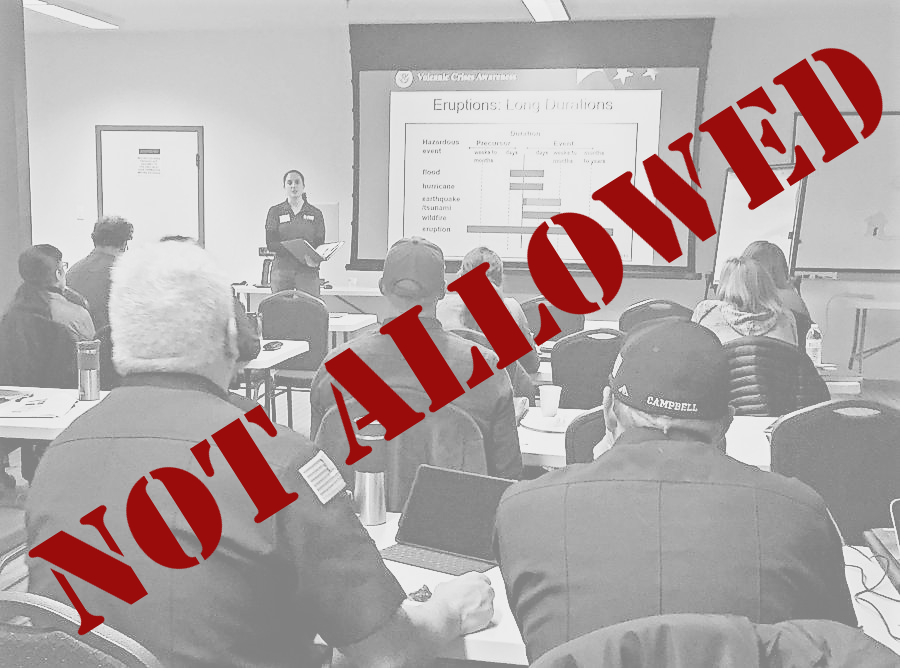The author leading a FEMA Volcanic Crisis Awareness course for emergency responders and land managers near Lassen Volcano, CA in 2017.
It’s been 28 days since I, my colleagues and 800,000 or so others were informed that some of our political leaders were okay with using us to make a point. 28 days since 380,000 of us were told we weren’t allowed work at all. 28 days since 420,000 of us were told that we had to work without pay. (That number is even higher this week.)
You’d think that more people would be angry about this kind of thing. About not getting the value for the money that’s been authorized as backpay for federal workers who haven’t actually been allowed to do their work. Or about how much this political posturing is costing American taxpayers at the national, state and local levels. But instead, federal workers have had to listen to people suggest that a shutdown should be a way to get rid of the “non-essential” government employees, because why do we need them if they’re not essential?
The emotional aspects of being belittled as useless aside, answer #1 is semantics: “non-essential” doesn’t mean what the author thinks it means. Guidance from the U.S. Office of Personnel Management describes “essential” or “excepted” employees as those who are “performing emergency work involving the safety of human life or the protection of property or performing certain other types of excepted work.”
But as those of us who have actually served in an emergency response know, being reactive to a crisis is more expensive, less efficient, and more wasteful than doing the work ahead of time – not to mention that maintaining normal operations is important for preventing some crises before they happen.
I’ll use my job as an example. I was recently hired permanently at the California Volcano Observatory, to continue the work I was doing for four years as a postdoc, and take on new duties. These include:
- Running computer models already developed and paid for by USGS scientists to help determine why and how volcanoes collapse (something we’ve seen dramatic evidence of at Anak Krakatau recently), as well as where volcanic mudflows (lahars) could travel on Cascade volcanoes, such as Mount Shasta. These models are directly applicable to work I could be doing with communities around these volcanoes, helping them plan safety routes and make land-use choices that would prevent people from losing their lives and property. Without scientists doing these kinds of studies and making maps to interpret their results, we’re left with outdated bulls-eye hazard zones that could cost people unnecessary time and money.
- Updating and improving information available to the State of California Office of Emergency Services, emergency responders and land manager, and residents about hazards around volcanoes. California has 12 active volcanoes that have a moderate-to-very-high-threat designation, meaning they could both erupt and impact significant swathes of the state’s population, infrastructure and resources. The last eruption in California was just over 100 years ago, which is peanuts in geologic time, and the chance of the state seeing another eruption in the next 30 years is roughly equivalent to the chance of a large earthquake on the San Andreas fault in San Francisco or Los Angeles. Without correctly interpreting this information for USGS partners, providing it in a way that they can use for vulnerability and risk analysis, and making sure they know how our scientific expertise can inform decision-making, we leave them in the dark about how to respond to volcanic crises when they occur.
- Training emergency and land managers to prepare them for volcanic crises. The National Disaster Preparedness Training Center (NDPTC) runs a FEMA-certified course specifically to do this, which I was certified to teach last year. My observatory has run several of these trainings already, and would normally be ready to do more. With the last eruption in California over a century ago, people just don’t have experience or institutional memory of what it’s like to deal with a volcanic crisis, and the USGS does as much as we can to remedy that. Otherwise, the next volcanic eruption could turn into a real disaster.
- Maintaining USGS Volcanoes websites and social media accounts and giving interviews about volcanic phenomena in the United States. During the 2018 eruption at Kilauea, my colleagues and I worked countless hours providing scientifically sound information and answering questions about the eruption, especially from local folks who were affected. If you read about the eruption in the “traditional” news or in online articles, chances are that it was a USGS scientist, social media account or website that gave out that information. We don’t just do this during a crisis, we do this all the time. Right now all of those outlets have gone silent because we’re not allowed to use them, and we’ve been directed to refer all media requests to the DOI Communications Office. If there were another volcanic crisis, we might not be able to communicate the way we did last summer, to the detriment of those we’re supposed to protect.
- Preserving our research and experiences for future scientists and partners. I have several publications lined up that I’d like to be working on right now: the aforementioned lahar research, material property information that could be used in future volcanic stability modeling, media experiences and lessons learned from the Kilauea eruption, scenarios for what an eruption of a California volcano might look like in terms of impacts on populations, infrastructure and resources.
I also do crisis work – I spent more than a month in Hawaii assisting with the Kilauea eruption response last summer. But when I’m not at an erupting volcano, I’m doing all of these things to help people prepare for the next volcanic crisis, whether here or elsewhere. I’m not doing these for myself – I live in a place that won’t be directly affected by volcanoes. I’m not doing this for the money – I can just barely afford my rent because my workplace is in one of the most expensive regions in the country.
I want to be doing this work because I want to help people. I worked long and hard to get a job at the USGS, a place that I’ve dreamed of working ever since I knew it existed. I love my work, and my colleagues, and the important science that we do. But because some of our political leaders have decided it’s okay to use federal employees as political pawns, I am legally forbidden from doing my job, and so are most of my colleagues. It’s a pointless waste of money and time for taxpayers (including me), and frustrating, anger-inducing, and needlessly cruel to the federal workers, contractors, and people who depend on government resources and workers for their businesses, finances and wellbeing. And things are only going to get worse.
Federal workers do a lot of important things behind the scenes so that worse things don’t happen. That work is important whether it’s written about in the media or not, from the highest levels of management on down to security guards and janitors. My colleagues and I were hired for a reason, as was everyone who took an oath to become a civil servant and serve the good of our country. We took these jobs because we wanted to help our fellow citizens in some way. We’d love to be working for our pay right now. We’d like to not have to go through this year after year. We’d like to not watch each other struggle to pay our rent, and buy food, and get medical care, and provide for our families.
And we’d really, really like not to be the collateral damage of political maneuvering over which we have no control.














/https://tf-cmsv2-smithsonianmag-media.s3.amazonaws.com/filer_public/34/31/3431771d-41e2-4f97-aed2-c5f1df5295da/gettyimages-1441066266_web.jpg)






Discussion about this post